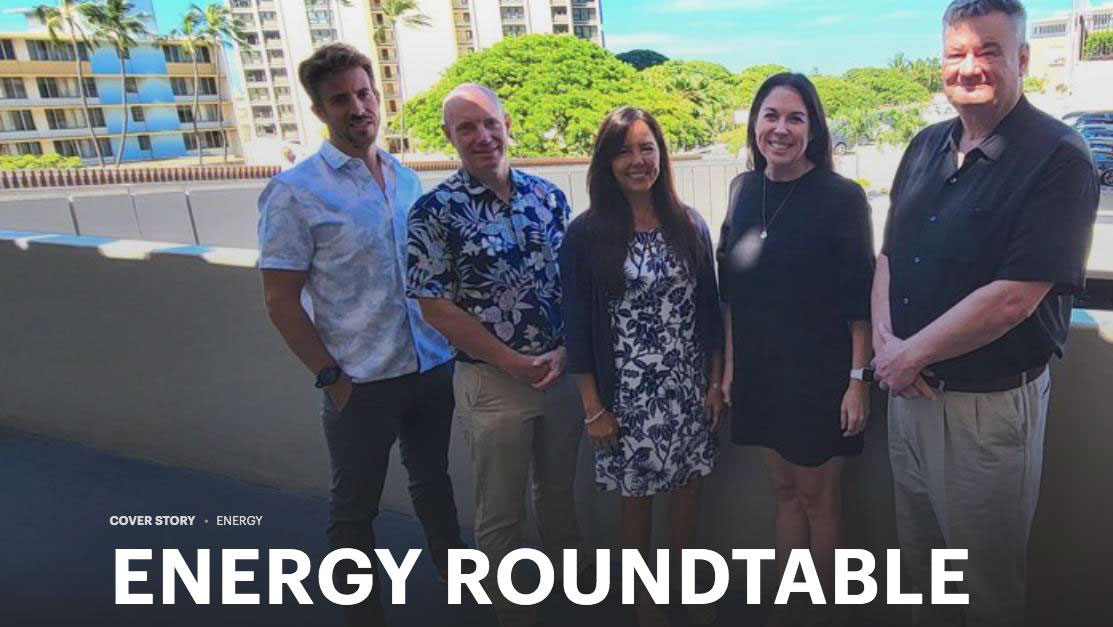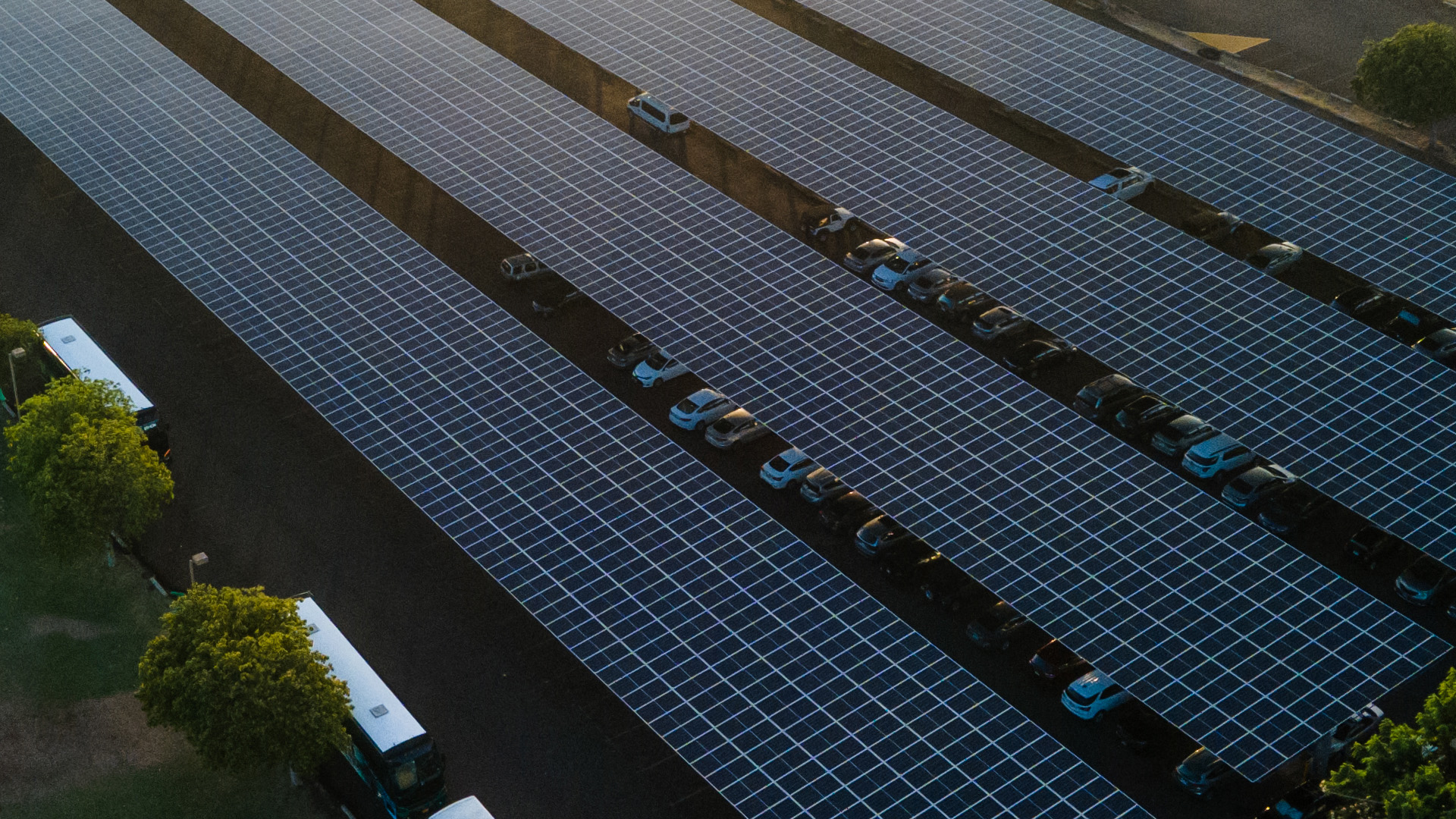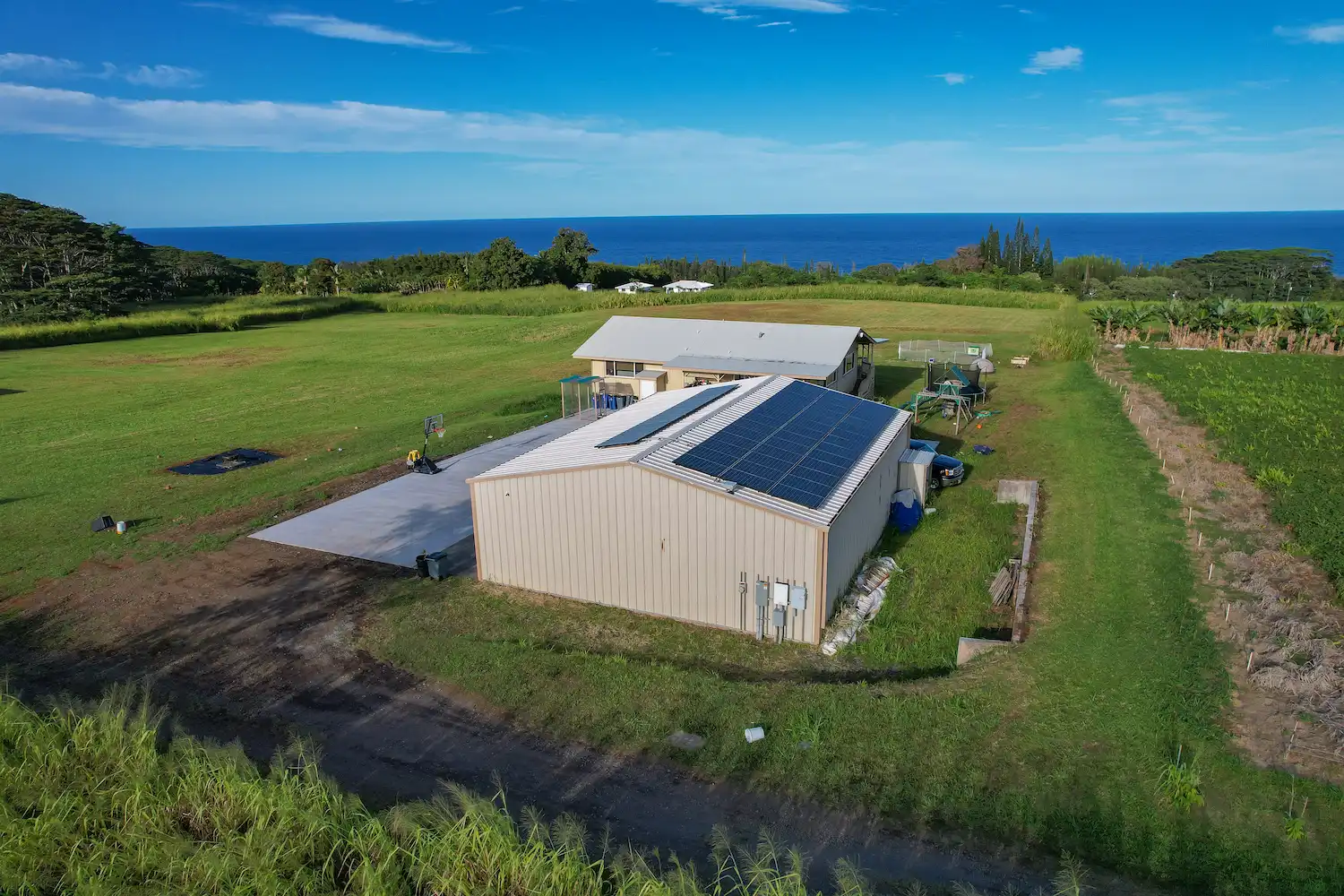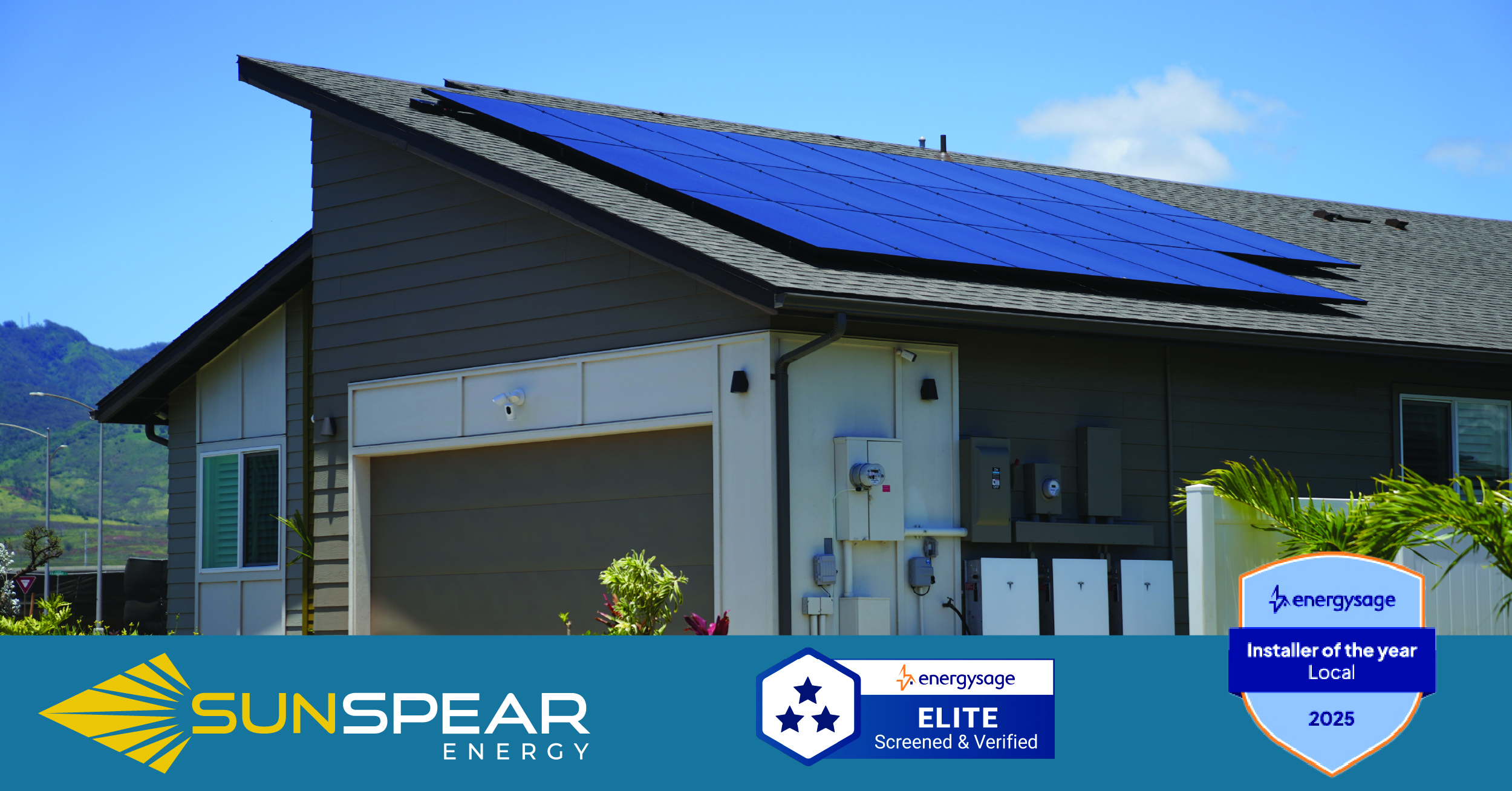
The panelists at the Energy Roundtable included, from left: Jeff Kaemmerlen, CEO of Sunspear Energy; Eric Wright, president of Par Hawaii; Sandra Larsen, market business leader for AES Hawaii; Caroline Carl, executive director of Hawaii Energy; communications at Hawaii Electric.
STEPHANIE SALMONS
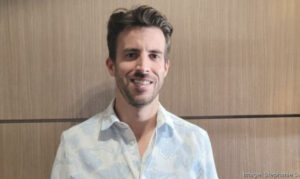
Jeff Kaemmerlen, CEO of Sunspear Energy
Jul 7, 2023
Hawaii was the first state in the country to commit to a 100% clean renewable energy goal by the year 2045, according to the Hawaii State Energy Office. This lofty objective was top-of-mind among the five panelists at Pacific Business News’ annual Energy Roundtable held in person on June 9 at Ala Moana Hotel.
The local energy experts shared insights into how far along the state is to its 100% renewable energy goal, projects in the pipeline today that can helpHawaii reach it, what consumers can expect during the transition, government roadblocks, how renewable energy can be made more equitable, and more.
Understanding Hawaii’s renewable energy goal
In the days leading up to the roundtable, Par Hawaii President Eric Wright said he had been meeting with Gov. Josh Green’s office to try to establish incentives for sustainable aviation fuel that work for Hawaii. These are similar to incentives that exist for renewable fuels in other states, like Washington, where State Gov. Jay Inslee recently signed a tax incentive worth up to $2 a gallon into law, according to The Seattle Times.
“Fuel is really easy to transport. …The worst thing that can happen is we’re making sustainable aviation fuel here in Hawaii that’s just going back to Washington to capture that tax credit, right? So we’re starting to engage stakeholders.”
Hawaii Energy Executive Director Caroline Carl, who was active in the last legislative session, said her biggest takeaway would be “encouraging government elected officials and other state agencies to reach out to the industry directly.”
“We can provide transparent, factual information about the execution of projects and the headwinds and the tailwinds,” Carl said.
There have been some headwinds with permitting and getting projects online on the distribution side, Sunspear Energy CEO Jeff Kaemmerlen said, but pointed out the August 2022 approval of the Inflation Reduction Act, which he called “themost significant piece of clean energy legislation that I’m aware of to date.”
The Inflation Reduction Act is a federal law that included $370 billion in climate provisions and creates incentives for homeowners to install energy-efficient appliances, according to the website for the U.S. Environmental Protection Agency.
“We’re just glad to have 10-plus years of policy certainty that really has never existed in the time that I’ve been on the ‘solar coaster,’” Kaemmerlen said.
In 2008, the Hawaii Clean Energy Initiative was launched when the state and the U.S. Department of Energy signed a memorandum of understanding to reduce Hawaii’s dependence on imported fossil fuels. At that time, it was estimated that 60% to 70% of the state’s future energy needs could be met by renewable energy sources, according to the Hawaii State Energy Office. In 2015, then-Gov. David Ige signed into law House Bill 623, a clean energy goal to become completely energy self-sustaining, using 100% renewable sources, by 2045.
Last year, 28.2% of Oahu’s electricity was generated from renewable sources, 35.6% in Maui County, and 47.9% on Hawaii Island, Hawaiian Electric reported. The majority of this renewable energy came from customer-sited, grid-connected renewable solar and wind. Hawaiian Electric recently released a plan, called the Integrated Grid Plan, or IGP, which lays out routes for how the state can reach the 2045 goal, and is the result of a five-year-long effort that had “a lot of input from real people,” said Jim Kelly, vice president of government and community relations and corporate communications at Hawaiian Electric.
“This transition is not going to be free, but it’s also going to be a lot less expensive than if we just stay on the path that we’re on right now, which is to keep burning fossil fuels and relying on stuff that is imported to make electricity,” he added.
If significant progress is not made by 2030, “We’re really going to be in a hole,” he said.
“Most of it has really got to get done over the next seven years,” Kelly said. “We’ve really got to build that strong foundation — and I think we’re doing that — but were ally got set back by the [Covid-19] pandemic.”
Projects in the pipeline
Hawaiian Electric has 27 new and upcoming renewable energy projects, according to the company’s’ website. These include the Kapolei Energy Storage project in West Oahu, which is “one of the biggest battery energy storage projects in the world,” Kelly said. The 185-megawatt battery is expected to cost more than $500 million through its 20-year contract, Former PUC Chairperson Jay Griffin previously told PBN in an email.
The electricity provider also recently opened its stage three request for proposals for renewable energy projects on Oahu and Maui. Unlike the previous two stages, for the first time, Hawaiian Electric also requested for the development of firm renewable energy — energy capable of being consistently produced and available at all times, and can be “turned on or turned off,” Kelly said.
By October, Hawaiian Electric will have compiled the final list of projects, according to Kelly.
In response to a question about the necessity of firm renewable energy, Kelly said, “It’s essential. We’ve got to keep the lights on. … We need everything to be on the table. … We’re not going to hit our goals if we keep saying no to things.”
Hawaiian Electric also announced in May its proposal to replace six fossil fuel-powered generators at its 85-year-old Waiau Power Plant in Pearl City with fuel-flexible units that can provide reliable, firm generation, as reported by PBN at the time.
Par Hawaii — which supplies fuel to Hawaiian Electric, airlines, and the military — recently partnered with conservation nonprofit Pono Pacific to develop local sources of vegetable and other plant-based oil to produce renewable diesel and sustainable aviation fuel. This follows a $90 million investment into the production of renewable fuel made with sustainable feedstocks, as reported by PBN. Within two years, Par Hawaii will have a unit at the refinery making 60 million gallons of renewable diesel a year, Wright said.
“We think liquid fuels are always going to be part of the mix. Having a rotating generator on the grid really stabilizes the grid in a way that other resources can’t,” he added.
AES Hawaii currently has nine projects in the pipeline — four of which are operational, while five are under development. The energy company recently brought online Waikoloa Solar + Storage, Hawaii Island’s first and largest solar-plus-storage project. It can generate up to 30 megawatts of power, supported by a120 megawatt-hour battery energy storage system, and is now saving customers about $5 a month on their electricity bills, as announced by the company in May.
Other AES Hawaii projects in the pipeline include its first project on Oahu, which will come online later this year, as well as Kuihilani Solar + Storage on Maui, and two additional solar projects on Oahu slated to come online in 2024.
On Kauai, the company’s West Kauai Energy Project, a hydropump storage and solar project, has a goal of being operational by 2026, Kauai Island Utility Cooperative spokesperson Beth Tokioka previously told PBN. When complete, WKEP is slated to take Kauai to approximately 80% of its power coming from renewable sources, Larsen said.
“Kauai is much closer than the rest of the islands to getting to 100%, which is really exciting,” she said.
Hawaii Energy’s projects have saved customers more than $2 billion in electricity bill savings, and the company’s programs see more than 3,000 commercial efficiency projects come through the portfolio each year, Carl said. Hawaii Energy is launching in August its fourth year of its EmPower grant program, which is targeted at small businesses and nonprofits, and provides them with grant money to upgrade equipment. Hawaii Energy has contributed more than $4 million so far to the program, according to Carl.
Hawaii Energy’s efficiency programs have also shifted with the closure last fall of the AES Hawaii Power Plant, Hawaii’s last coal-fired plant, as well as concerns around availability of electricity, she said. Hawaii Energy has launched a new program called “Power Move” that provides incentives to reduce peak usage, and for the first time in its portfolio, has rolled in battery storage to support a Hawaiian Electric battery bonus program.
“We really see the critical need to be continuing to focus on efficiency and demand-side management in conjunction with the renewable portfolio and the decarbonization efforts,” Carl said.
Local solar company Sunspear Energy — which does commercial, residential, rooftop, and carports installations as well as some small utility-scale work — is in the process of installing a battery storage system at water park Wet ‘n Wild. In 2021, it installed a 1.3 megawatt carport system that currently provides enough power to cover 100% of the electricity needs of the park during the hours it is open, according to Kaemmerlen.
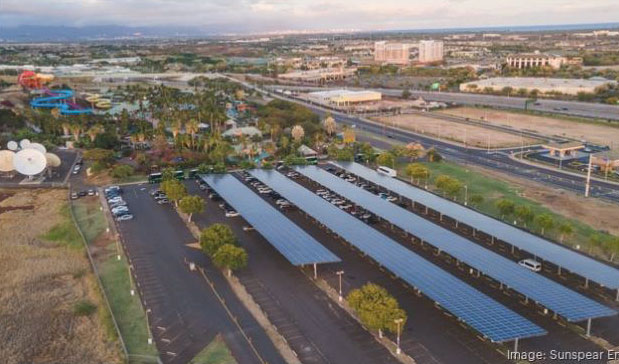
Sunspear Energy installed a 1.3 MW solar system at Wet ‘n’ Wild in 2021, to fulfill 100% of the parks energy needs.
Sunspear Energy
Sunspear Energy also recently signed a lease for a new office and warehouse space that will be larger and give the company the opportunity to host educational seminars and training workshops, he said.
“It’s cool that we’re all kind of coming together now to work with Hawaiian Electric to enable the clean energy transition,” Kaemmerlen said. “… It’s been a really exciting, dynamic time on the ‘solar coaster.’”
The effect on rates and accessibility
The Russian invasion of Ukraine caused a disruption in the market as the price of crude oil increased from about $75 to $130, but crude oil today is around $70, so it is “as cheap as it’s been in a couple years,” Wright said.
Since November, electricity bills on every island have been dropping, Kelly added. On Hawaii Island, electricity bills are almost exactly what they were prior to the Russian invasion of Ukraine, and Maui is close behind. The typical bill on Oahu is still high due to the coal plant closing, and is about $12 higher today thanit was prior to its closure, Kelly said.
Hawaiian Electric also recently announced it is launching a time-of-use rate pilot program called “Shift and Save.” The program gives customers an incentive to shift some of their electricity usage out of the peak 5 to 9 p.m. period into the daytime “when there is abundant, plentiful” solar available on every island, Kelly said.
“I think that [the program] will be the biggest change in over a century to how people get billed for their electricity and it’s going to make people be much more active consumers of electricity,” he said.
The pilot program is going to involve 4% of customers — about 17,000 residential and business customers — selected at random, who can also choose to opt out. There are also circuit breakers built into the program for the first six months as people get used to the switch. Time-of-use programs are used on the Mainland in different areas, and Hawaiian Electric wants to see how it works in Hawaii, according to Kelly. Customer bills can only go up $10 for residential customers and 4% for businesses. The program has not yet been approved by the Public Utilities Commission, but an announcement on the rollout of the program will likely be announced in the coming months, he said.
Hawaii Energy’s core mission is to help lower energy burden and cost for residents and businesses, Carl added, and said that the company will be working closely with Hawaiian Electric during the time-of-use rate pilot to support people interested in shifting their load with different technologies or smart controls.
“It fundamentally starts with just understanding how we use electricity in our home and how that affects our bill. It’s complex. … We’re really trying to build that energy literacy,” Carl said.
The renewable energy transition has spurred questions about how solar can be made more equitable. To promote accessibility, Hawaiian Electric in March announced it had selected one project on Oahu and four projects on Hawaii Island in the second phase of its “shared solar,” or community-based renewable energy, program, which allows subscribers without privately-owned rooftop solar to subscribe to a local renewable energy facility and receive credits on their monthly electricity bill.
One of the barriers to accessing solar on the residential side is financing, said Kaemmerlen, who has been actively trying to work with some of the local banks, as well as with the Hawaii Green Infrastructure Authority’s Green Energy Market Securitization program, to help customers with access to solar financing.
“Electric prices are really expensive here for residential customers,” Kaemmerlen said. “So generally, if they can afford their electric bill, they can afford the monthly payment on a solar [photovoltaic] system.”
Simple upgrades in energy efficiency can be used to lower high electricity bills among renters or those living in multifamily or affordable housing, Carl added. Hawaii Energy has an “Energy Smart 4 Homes” program, an energy-saving opportunity for residential properties that is “essentially a walkthrough audit and replacement” of lighting, shower heads, and more, Carl said.
“Understanding how we affect what our electric bill is — I think that’s a critical priority,” Carl said.
But the faster Hawaii brings utility-scale solar online, “the more it will help statewide across all individuals and not just certain households,” Larsen added.
“I know we’re talking about residential and PV, but I think this is where I want to put in a plug for the fact that bringing on utility-scale solar is really what’s going to help,” Larsen said.
Creating jobs and highlighting the industry
Amid the renewable energy transition, AES Hawaii has created around 1,400 jobsacross all of its projects and aims to use a local workforce for construction, according to Larsen. When AES Hawaii closed Hawaii’s final coal plant in September 2022, the company worked with community partners to locate clean energy positions for employees from the plant who wanted to continue employment, according to Larsen, who said some of the coal plant’s workers had been with the plant since it opened in 1992.
The company also works with schools on workforce development and create educational pathways to “create a road for kids to continue to work here and to go into this industry,” she said.
“For me, it’s really important that we get kids excited about this industry and about having a future in renewable energy,” Larsen said.
At Sunspear, Kaemmerlen has focused on curating a “positive company culture” and has tried to provide opportunities for cross-training in different areas. Hawaii Energy similarly has hosted a number of professional development and training events, according to Carl.
“I think one cool thing about our industry is it’s very much a convergence of different fields. You have the construction side, engineering, there’s a finance aspect to it,” Kaemmerlen said.
Sunspear also has hired a full-time employee dedicated to recruiting, but Kaemmerlen said there are still challenges when it comes to finding electricians and skilled workers.
“We’re going to need a lot of electricians to enable this clean energy transition over the coming decade,” he said. “I hope as more kids go through school … that they gravitate toward the trades.”

